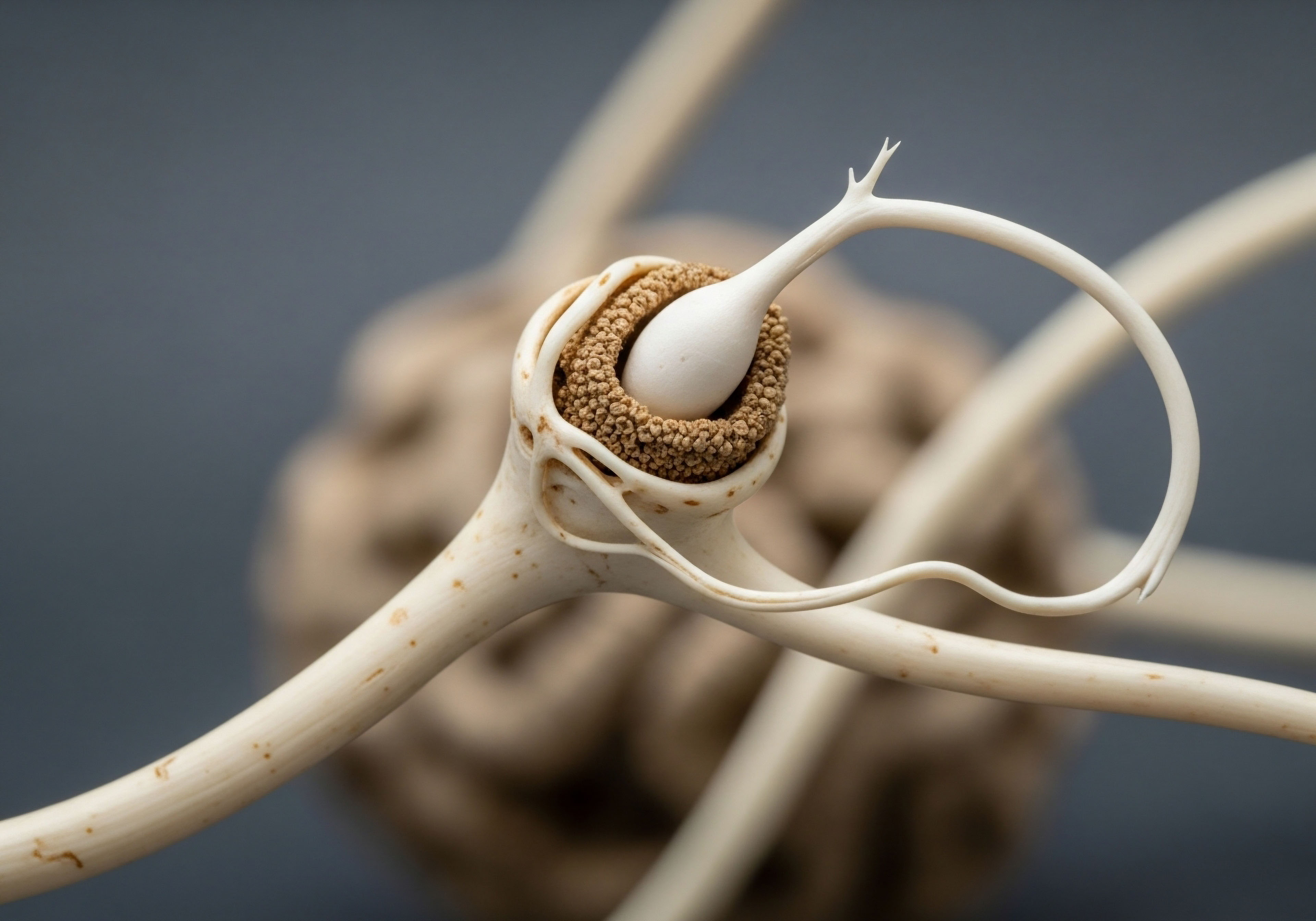

Fundamentals
The conversation around optimizing male hormonal health often begins and ends with a number. That number, the serum testosterone level, becomes a target. Yet, the lived experience of vitality, clarity, and strength is rarely governed by a single data point.
You may have felt this yourself ∞ the disconnect between lab results that appear “normal” and a persistent feeling of being unwell. This experience is valid. It points to a deeper biological truth ∞ the endocrine system operates as an intricate communication network, where the volume of one messenger, testosterone, is only part of the story. The way that message is received, converted, and balanced by other signals is where true physiological harmony is found.
Ancillary medications in a testosterone replacement therapy (TRT) protocol are the conductors of this endocrine orchestra. Their purpose is to manage the downstream effects and feedback signals that arise when exogenous testosterone is introduced. Introducing external testosterone sends a powerful signal through the body, but it also quiets the body’s own internal production.
This central command system, known as the Hypothalamic-Pituitary-Gonadal (HPG) axis, is a sophisticated feedback loop designed to maintain equilibrium. When it senses an abundance of testosterone, it logically reduces its own signals to produce more. Ancillary agents are introduced to modulate this response, ensuring the entire system, not just one part of it, is supported.
True hormonal optimization is achieved by balancing the entire endocrine network, where testosterone is one vital component among many.

The Central Command the HPG Axis
Imagine the HPG axis as a three-tiered management structure. The hypothalamus is the CEO, sending out high-level directives. The pituitary gland is the regional manager, interpreting those directives and issuing specific orders. The gonads, or testes, are the factory floor, carrying out the orders to produce testosterone.
This system is regulated by feedback. When testosterone levels are sufficient, the factory floor sends a message back up to management, telling them to slow down production. Exogenous testosterone is like a massive external shipment arriving at the factory; it floods the system, and management immediately shuts down internal operations. Ancillary medications work at different levels of this command chain to keep internal operations online or to manage the byproducts of this new, larger supply.

Testosterone and Its Inevitable Conversion
Once in the bloodstream, testosterone does not remain static. A portion of it is converted into a form of estrogen, specifically estradiol, by an enzyme called aromatase. This process is natural and necessary; men require a certain amount of estradiol for cognitive function, bone health, and cardiovascular wellness.
On a TRT protocol, however, the elevated levels of testosterone can lead to an excessive amount of this conversion, resulting in an imbalance. This hormonal shift can manifest as symptoms often attributed incorrectly to the testosterone itself, such as water retention, mood volatility, or gynecomastia. Understanding this conversion is the first step in comprehending why a TRT dose is rarely a standalone variable. It is, instead, the foundational element upon which a broader strategy of systemic balance is built.


Intermediate
Adjusting a testosterone dosage is a process of systemic calibration, guided by the influence of specific ancillary medications. These agents are tools that allow a clinician to sculpt the hormonal environment, addressing the interconnected pathways that testosterone influences. By modulating estrogen levels and preserving the body’s innate signaling architecture, these medications change the fundamental equation of therapy.
The goal shifts from simply elevating a testosterone number to optimizing the critical ratio between testosterone and its metabolites, thereby refining the clinical outcome and enhancing the individual’s sense of well-being.

Aromatase Inhibitors the Estrogen Brake
Aromatase inhibitors (AIs), such as Anastrozole, are perhaps the most common type of ancillary medication used in TRT protocols. Their mechanism is direct ∞ they block the action of the aromatase enzyme, which is responsible for converting testosterone into estradiol. By applying this enzymatic brake, an AI directly lowers the amount of circulating estrogen.
This intervention has a profound effect on the required testosterone dose. An individual who is a “high aromatizer” ∞ meaning they convert testosterone to estrogen at a high rate due to factors like genetics or body composition ∞ might experience high-estrogen side effects even on a moderate dose of testosterone.
Introducing Anastrozole reduces this conversion, which accomplishes two things. First, it mitigates the estrogenic side effects. Second, it often allows for a lower, more physiological dose of testosterone to be effective, as less of it is being diverted down the estrogen pathway. The testosterone dose is adjusted downward in response to the AI’s presence, seeking the point where androgenic benefits are maximized without creating an estrogen-deficient state, which carries its own risks to libido, bone density, and mood.
Ancillary medications reshape the hormonal landscape, requiring testosterone doses to be adjusted based on systemic response rather than a static number.

How Do Ancillary Agents Preserve Natural Function?
While AIs manage the metabolic byproducts of testosterone, other ancillaries work to preserve the integrity of the HPG axis. These agents are particularly relevant for men who wish to maintain fertility or testicular size while on therapy.
- Gonadorelin ∞ This peptide is a synthetic analog of Gonadotropin-Releasing Hormone (GnRH), the “CEO” signal from the hypothalamus. When administered in a pulsatile fashion, it stimulates the pituitary gland to release Luteinizing Hormone (LH) and Follicle-Stimulating Hormone (FSH). This action keeps the testes active, promoting endogenous testosterone production and spermatogenesis. When Gonadorelin is part of a protocol, the total effective testosterone level is a sum of both the exogenous dose and the preserved endogenous production. Consequently, the injectable testosterone dose may be titrated differently, as the goal is to supplement, not entirely replace, the body’s own output.
- Selective Estrogen Receptor Modulators (SERMs) ∞ Medications like Enclomiphene or Clomiphene Citrate work in a more nuanced way. They selectively block estrogen receptors in the pituitary gland. By preventing estrogen from delivering its negative feedback signal, SERMs effectively trick the pituitary into sensing low estrogen levels. Its response is to increase the output of LH and FSH to stimulate the testes. In a TRT context, Enclomiphene can be used to maintain a baseline of natural signaling, which again influences the necessary dose of external testosterone. For men on a fertility-sparing or post-TRT protocol, these agents form the cornerstone of therapy, restarting the entire HPG axis.
The interplay between these medications and the testosterone dose is a clinical art informed by science. The table below illustrates how the therapeutic strategy shifts with the inclusion of these agents.
| Therapy Protocol | Primary Goal | Key Ancillary | Influence on Testosterone Dose |
|---|---|---|---|
| Testosterone Monotherapy | Raise serum testosterone to relieve symptoms. | None | Dose is titrated based on total testosterone levels and symptom relief. |
| TRT with Aromatase Inhibitor | Control estrogen conversion and optimize T:E2 ratio. | Anastrozole | Dose may be reduced to achieve benefits without estrogen suppression. |
| TRT with HPG Axis Support | Maintain testicular function and fertility. | Gonadorelin | Dose is calibrated to supplement, not fully suppress, natural production. |
| HPG Axis Restart Protocol | Stimulate endogenous testosterone production. | Enclomiphene/Clomid | Exogenous testosterone is discontinued entirely. |


Academic
A sophisticated approach to testosterone dose modulation transcends the measurement of total serum testosterone, focusing instead on the dynamic equilibrium within the steroidogenic cascade and its governing feedback mechanisms. The introduction of ancillary medications into a therapeutic protocol is an intervention that fundamentally alters this equilibrium.
It requires a clinical mindset rooted in systems biology, where the testosterone dosage becomes a dependent variable, adjusted in response to targeted manipulations of enzymatic conversion rates and neuroendocrine signaling. The ultimate objective is the restoration of a physiological hormonal milieu that aligns with optimal clinical outcomes, a state that is often reflected more accurately by the ratio of testosterone to estradiol (T/E2) than by the absolute value of testosterone alone.

Pharmacokinetic Interplay and Dosing Chronology
The administration of Testosterone Cypionate via intramuscular injection creates predictable pharmacokinetic peaks and troughs. Serum testosterone levels typically peak 24-48 hours post-injection and gradually decline over the following days. The activity of the aromatase enzyme mirrors this fluctuation, leading to a corresponding rise and fall in estradiol levels.
The dosing schedule of an oral aromatase inhibitor like Anastrozole, which has its own distinct half-life, must be intelligently synchronized with this cycle. A common protocol of administering Anastrozole twice weekly is designed to dampen the peak estradiol conversion that follows the testosterone injection, maintaining a more stable T/E2 ratio throughout the week.
The adjustment of the testosterone dose is therefore a function of this interplay. If blood analysis reveals that estradiol is suppressed too aggressively at the trough (just before the next injection), it may indicate that the Anastrozole dose is too high relative to the testosterone dose.
Conversely, elevated estradiol with persistent symptoms suggests either an insufficient AI dose or, more critically, a testosterone dose that is excessively supraphysiological for that individual’s enzymatic makeup, producing more estrogen than the AI can reasonably control. In this latter scenario, the correct clinical decision is often to lower the testosterone dose. This reduces the substrate available for the aromatase enzyme, thereby addressing the root cause of the imbalance.
Effective dose adjustment requires synchronizing the pharmacokinetics of testosterone esters with the pharmacodynamics of ancillary agents to maintain systemic hormonal stability.

What Is the Role of Neuroendocrine Feedback Modulation?
Ancillary agents like Gonadorelin and Enclomiphene citrate introduce another layer of complexity by directly modulating the Hypothalamic-Pituitary-Gonadal (HPG) axis. Gonadorelin, a GnRH agonist, provides an external, pulsatile stimulus to the pituitary gonadotropes, eliciting LH and FSH release. This maintains Leydig cell function and steroidogenesis.
The testosterone dose in such a protocol is adjusted to account for this preserved endogenous output. The goal is to bridge the gap between the body’s stimulated production and the desired therapeutic level, a fundamentally different paradigm from the complete suppression and replacement model of testosterone monotherapy.
Enclomiphene citrate, a selective estrogen receptor modulator (SERM), functions by creating a state of perceived estrogen deficiency at the level of the hypothalamus and pituitary. By antagonizing the estrogen receptor at these sites, it disrupts the negative feedback loop that would otherwise suppress GnRH and LH secretion.
This results in a sustained, centrally-driven increase in endogenous testosterone production. When used alongside a low dose of TRT, or as a standalone therapy, the entire concept of “dose adjustment” shifts from managing an external supply to modulating the body’s internal control system. The table below outlines the primary mechanisms and their direct impact on dosing logic.
| Ancillary Medication | Primary Mechanism of Action | Biological Target | Consequence for Testosterone Dose Adjustment |
|---|---|---|---|
| Anastrozole | Inhibition of aromatase enzyme | Peripheral and central tissues | Dose is titrated to optimize the Testosterone:Estradiol ratio. |
| Gonadorelin | GnRH receptor agonism | Anterior Pituitary Gland | Dose supplements the preserved endogenous production. |
| Enclomiphene Citrate | Estrogen receptor antagonism | Hypothalamus and Pituitary | Dose is minimized or eliminated in favor of endogenous stimulation. |

Genetic Polymorphisms and Individual Variability
Further academic consideration must be given to individual genetic variability, particularly in the CYP19A1 gene that codes for the aromatase enzyme. Polymorphisms in this gene can lead to significant differences in aromatization efficiency among individuals. A patient with a genetic predisposition for high aromatase activity will require a different ancillary strategy, and consequently a different testosterone dose, than someone with lower baseline activity.
This highlights the limitation of standardized protocols and underscores the necessity of a personalized approach, where testosterone dose adjustments are the final step in a comprehensive strategy that accounts for an individual’s unique biochemical and genetic landscape. The integration of pharmacogenomics into hormonal therapy represents the next frontier in achieving truly personalized and optimized clinical outcomes.

References
- Pastuszak, Alexander W. and Larry I. Lipshultz. “Enclomiphene citrate for the treatment of secondary male hypogonadism.” Expert opinion on pharmacotherapy, vol. 17, no. 11, 2016, pp. 1561-1567.
- Rochira, Vincenzo, et al. “Official position statement of the Italian Society of Andrology and Sexual Medicine (SIAMS) ∞ The use of aromatase inhibitors in male disorders.” Journal of Endocrinological Investigation, vol. 43, no. 11, 2020, pp. 1513-1528.
- “Gonadorelin ∞ Uses, Interactions, Mechanism of Action.” DrugBank Online, Accessed 22 Aug. 2025.
- Tan, Ronald S. et al. “A practical guide to the management of gynecomastia.” Singapore Medical Journal, vol. 55, no. 5, 2014, pp. 249-253.
- Lunenfeld, Bruno, et al. “Recommendations on the diagnosis, treatment and monitoring of hypogonadism in men.” The Aging Male, vol. 18, no. 1, 2015, pp. 5-15.

Reflection
The information presented here maps the biological and clinical logic of hormonal optimization. This knowledge serves as a powerful tool, shifting the perspective from passive treatment to active, informed participation in your own health. Your unique physiology is the terrain, and the data from lab work and your own experience are the compass.
Consider how your body’s systems communicate. Reflect on the concept of balance over brute force. This understanding is the foundation upon which a truly personalized and effective wellness protocol is built, in collaboration with a clinical guide who can help navigate the complexities of your individual journey toward vitality.

Glossary

serum testosterone

testosterone replacement therapy

ancillary medications

ancillary agents

pituitary gland

hpg axis

testosterone levels

aromatase enzyme

anastrozole

endogenous testosterone production

endogenous production

estrogen receptor

aromatase inhibitor

enclomiphene citrate

gonadorelin

selective estrogen receptor modulator

endogenous testosterone




